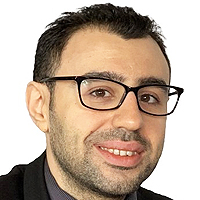Differential roles of trithorax protein MLL-1 in regulating neuronal Ion channels
Published on: 8th September, 2021
OCLC Number/Unique Identifier: 9244745887
Repressive regulation of potassium channel genes by Polycomb group (PcG) proteins contributes to PcG protein-mediated neuroprotection against neuronal ischemic injury, as seen in an ischemic stroke. Here we asked the question whether Trithorax group (TrxG) proteins, the antagonistic partners of PcG proteins (i.e, epigenetic activators targeting the same genes) may also regulate potassium channels. Results of patch-clamp studies on cultured neuronal cells showed that inhibition of TrxG protein MLL-1 led to an increase in potassium channel activity, an unexpected effect for a presumed gene activator. In contrast, decreased sodium currents were observed with MLL-1 inhibition. Increased or decreased levels of potassium channel protein Kv2.1 or sodium channel protein Nav1.2, respectively, were seen with MLL-1 inhibition, as determined by immunocytochemistry. These results, for the first time, demonstrate an involvement of TrxG protein MLL-1 in regulating neuronal ion channels, potentially repressing potassium channel genes.
A Genetic study in assisted reproduction and the risk of congenital anomalies
Published on: 12th October, 2021
OCLC Number/Unique Identifier: 9305465911
In vitro fertilization is one of the most common and effective procedure for thousands of couples worldwide who want to have a child and are unable to do so for various reasons. Diverse studies show that couples who conceive naturally after one year of trying had newborns with an increased risk of prematurity and low birth weight, compared with couples who conceived before completing one year of trying. Children from assisted reproduction (AR), have a 30% increased risk of prematurity and low birth weight, compared with children from infertile fathers. Regarding the conflicting results the present study aimed to record the frequency of genetic, congenital anomalies in children and adolescents who had examined in the last decade to the Clinical Genetics Clinic of the National and Kapodistrian University of Athens whose mothers had undergone assisted reproduction. The research process was conducted at the "Aghia Sofia" Children's Hospital based in Athens. However, the cases that were studied came from all over Greece. Initially, the researcher recorded the cases that came to the clinic of Clinical Genetics and whose conception occurred after technical assisted reproduction. After telephone communication and the consent of the parents, a live appointment was scheduled. In this meeting-interview all the provisions of the investigation and the protocol were asked and some elements of the medical history of the cases were confirmed. The total sample included 230 children and adolescents. The resulting data were recorded on a printed form/questionnaire. Then, they were registered electronically in the program SPSS 25.0 (Statistical Package for Social Sciences) with a specific unit code for each case/patient, followed by the processing and statistical analysis of the data as well as the recording of the results. The gender of the participants was male for 118 participants (51.3%) and 112 females (48.7%). Mean and standard deviation (SD) of maternal, paternal (at the time of delivery) age was equal to 36.38 (5.94) and 39.94 (6.58) respectively. The observed abdormalities were 35.53% psychomotor retardation, 23.68% facial abnormalities, 23.68% spinal cord abnormalities, 21.05% morphological abnormalities, 20.61% short stature, 19.74% developmental disorders, 19.30% heart disease, 16.67% neurological diseases, 14.47% genetic syndromes, 11.40% genital abnormalities, 8.33% limb abnormalities, 7.46% dermatological abnormalities, 6.14% eye abnormalities, 6.14% hypothyroidism, 5.70% endocrine disorders, 5.26%otolaryngology abnormalities, 2.63% disease of kidney, intestine, 2.19% vascular malformations. Regarding the karyotype chromosome analysis by G-banding technique, from the 230 children in: 24 (10.43%) a pathological result was found, in 158 children (68.70%) it was found normal (46, XX or 46, XY by case) without other findings, while in 48 children (20.87%) the test was not performed for various reasons. Regarding the results of molecular analysis (DNA) from the 230 children, in 50 (21.74%) a pathological finding was found, in 56 children (24.35%) no abnormalities were found and in 124 children (53.91%) no molecular analysis was performed for various reasons. In conclusion, the sample of this descriptive study is characterized as uniform in terms of the method of assisted reproduction since 96.24% had followed the classic IVF. Full-term pregnancy was associated with the appearance of malignancy and head morphological abnormalities (64.6%), normal pregnancy was associated with genetic syndromes (18.2%) and facial abnormalities (11.1%). It is recommended the screening oocyte and sperm donors in order to help protect the safety and health of donors, recipients, and future offspring. The present study confirms the association of the presence of congenital anomalies after in vitro fertilization (IVF). However, the absolute risk of developing severe dysplasias after an IVF procedure is limited.
The outcome of autologous hematopoietic stem cell transplantation in patients with multiple myeloma. The experience of King Fahad Specialist Hospital in Dammam, Saudi Arabia
Published on: 29th September, 2022
Background: Aautologous hematopoietic stem cell transplants (HSCT) is the standard of care for newly diagnosed patients with multiple myeloma (MM) who are eligible for autologous transplantation. Although cryopreservation is routinely employed, autologous HSCT can be performed using non-cryopreserved stem cells.Methods and materials: A retrospective study of patients with MM who received autologous HSCT between the 10th of October 2010 and the 31st of January 2022 at King Fahad Specialist Hospital (KFSH) in Dammam, Saudi Arabia was performed.Results: Over 11 years and 113 days, a total of 135 autologous HSCTs were performed for 119 patients with MM at our institution. Single autologous HSCTs were performed for 119 patients, while 16 of these patients received either planned tandem autologous transplants or second autografts due to either progression or relapse of their myeloma. The median age of patients with MM at autologous HSCT was 51.5 years. At presentation of their MM, the following high-risk (HR) features were encountered: stage III disease according to the revised international scoring system (RISS) in 12.3%; adverse cytogenetics in 31.93% of patients; advanced bone disease in 60.50%; and renal dysfunction or failure in 11.76% of patients. A total of 104 autologous HSCTs (77.04%) were performed without cryopreservation while 31 autografts (22.96%) were performed using cryopreserved apheresis stem cell products. Additionally, 54 autologous HSCTs (40.00%) were done at outpatient while 81 autografts (60.00%) were performed in an inpatient setting. Survival for 100 days post-HSCT for all patients with MM who received autologous transplants including those done at outpatient was 100%. The 4 years overall survival (OS) an progression-free survival (PFS) for patients with MM who received non- cryopreserved or fresh autologous HSCTs were 82% and 68% respectively.Conclusion: Autologous HSCT without cryopreservation is safe, and feasible and can lead to short-term as well as long-term outcomes that are comparable to autologous transplantation with cryopreservation. Non- cryopreserved autologous grafts allow the performance of autologous transplants in an outpatient setting to save beds and reduce costs.
Outcome of Outpatient Autologous Hematopoietic Stem Cell Transplantation in Patients with Multiple Myeloma and Relapsed and Refractory Hodgkin Lymphoma. The Experience of King Fahad Specialist Hospital in Dammam, Saudi Arabia
Published on: 8th March, 2023
Background: Autologous hematopoietic stem cell transplants (HSCT) is the standard of care for transplant-eligible patients with newly diagnosed multiple myeloma (MM) and patients with relapsed and refractory Hodgkin lymphoma (R/R-HL) who achieve chemosensitivity after salvage therapy. Although autologous HSCT is routinely performed in an inpatient setting, the procedure can safely be performed in an outpatient setting.Methods and materials: A retrospective study of patients with MM and R/R- HL who received outpatient autologous HSCT at King Fahad Specialist Hospital (KFSH) in Dammam, Saudi Arabia between the first of April 2017 and the 31st of January 2022 was performed.Results: Over the study period of 4 years and 10 months, a total of 90 outpatient autologous HSCTs were performed for 79 patients (54 patients with MM; 4 of them received planned tandem autografts and 7 other myeloma patients received second autologous HSCTs for relapsed or progressive disease; and 25 patients with R/R-HL) at our institution. The median ages of patients with MM and those with R/R-HL at HSCT were 50.4 years and 27.8 years respectively.At the presentation of their MM, the following high-risk (HR) features were encountered: stage II and III diseases according to the revised international scoring system (RISS) in 53.7%; adverse cytogenetics in 42.6% and extensive bone involvement in 53.7% of patients. In patients with HL at presentation, 48% of patients had stage IV disease according to Ann Arbor staging classification and 84% of patients had B symptoms.Survival for 100 days post-HSCT for all patients with MM and HL who received outpatient autologous transplants was 100%. For patients with MM, the overall survival (OS) rates at 3 years and 4 years post-HSCT were 80% and 67%, while the progression-free survival (PFS) rates over 3 years and 4 years were 58% and 38% respectively. For patients with HL, the OS at 6 years post-HSCT was 95% while the PFS rates at 3 years and 6 years post-HSCT were 84% and 62% respectively.Conclusion: Outpatient autologous HSCT for patients with MM and HL is safe, and feasible and can lead to short-term as well as long-term outcomes that are comparable to autologous transplantation performed in an inpatient setting. Additional benefits of outpatient autologous include saving beds and reducing hospital costs.
The prognostic value of p53 and WT1 expression in cancer: new molecular insights and epigenetics explanations lead to a new medical hypothesis
Published on: 1st June, 2023
This is a literature review study focusing on the expression of p53 and WT1. Both the p53 and WT1 proteins are tumor suppressors, which means that they play a role in preventing the progression into cancerous ones. If these proteins are altered or deleted, they lose the ability to carry out their role, which might result in the development of cancer. The primary objectives of this study were to review the literature regarding the expression of both p53 and WT1 and to investigate their prognostic significance; and to discuss our new hypothesis regarding the ratios of expression of WT1/p53, as well as our model regarding acute myeloid leukemia. In brief, the objectives were to make the focus in the suggested hypothesis as well as collecting the supportive literature. According to the findings of the current research, the level of expression of WT1 and p53 can indicate either a favorable or unfavorable prognosis for cancer patients. Further, we demonstrated that the expression, not just as a quality variable but also as a quantity variable, may have a more substantial explanation in the progression of tumors than we had previously thought. According to the theory that was derived from this research, if the expression of WT1/p53 (the expression is given as a ratio) is somewhere around 4, then p53 acts as though it were wild type and offers protection against tumors. In order to verify this idea, we need to do additional study.
Bimatoprost Ophthalmic Solution (BOS) 0.3 mg w/v for 1 Open Trial of Long-term Preventive Therapy of Migraine in 3 patients with Pathophysiologic Shift from Brain to Eye
Published on: 9th November, 2023
Known since antiquity, migraine is a complex primary disorder, an episodic painful Autonomic Nervous System (ANS) storm, generally following the stress/post-stress phase. Despite exhaustive study of neuropeptides, neurochemicals, molecules, neurogenetics, neuroimaging along with animal and human experiments over the last 50 years, the scientific basis of migraine remains unknown. Straddling eight decades from Cortical Spreading Depression (CSD) to Calcitonin-Gene Related Peptide (CGRP) and its antagonists, exponentially increasing data have failed to create a gestalt synthesis. This article lays cohesive and robust fundamental principles for the comprehension and management of migraine. The continuum between migraine and non-congestive Primary Open-Angle Glaucoma (POAG), Normal Tension Glaucoma (NTG), or Low-Tension Glaucoma (LTG) is advancing. The case of sustained remission of migraine attacks (> 75%) over 3 years - 5 years with ocular hypotensive topical Bimatoprost Ophthalmic Solution (BOS) 0.3% in an N-of-1 trial in 3 patients with refractory migraine is presented. A cause-effect-adaptive process underlies the ANS-stress/post-stress-linked biology of migraine. Vasopressin-serotonin-norepinephrine ‘homeostatic-adaptive system’ Lowers Intraocular Pressure (IOP), while enhancing anti-stress, antinociception, vasomotor, and behaviour control functions, thereby selectively decreasing algogenic neural traffic in the ophthalmic division of trigeminal nerve (V1), and, raising the threshold to develop migraine. Striking migraine headache-aborting feature of vomiting is also likely linked to a several hundred-fold increase in arginine-vasopressin secretion. Eye-cover tests and self-ocular digital displacement are essential to studying the visual aura. Real-time physical displacement of Scintillating Scotoma (SS) and floating ‘stars’ is reported. The basis of spontaneous onset and offset, self-limited duration of migraine attacks, as well as female preponderance, and age/menopause decline in prevalence, are elucidated. Intraocular implants with long-term ocular hypotensive effects, including bimatoprost, are the future of migraine management. Controlled trials are required to establish the migraine-preventive effect of topical bimatoprost, a revolutionary advance in neuroscience.
Association of Cytokine Gene Polymorphisms with Inflammatory Responses and Sepsis Outcomes in Surgical and Trauma Patients
Published on: 19th February, 2024
Sepsis, a life-threatening condition triggered by infection, poses a significant healthcare challenge with high mortality rates. The interplay between genetics and the immune response in sepsis, particularly in surgical and trauma patients, is complex and critical. Genetic polymorphisms, particularly in cytokine genes like TNF-α, IL-6, and IL-8, have been extensively studied for their influence on sepsis susceptibility, severity, and outcomes. Polymorphisms can alter gene expression and cytokine production, leading to variations in immune responses. Studies have also explored polymorphisms concerning sepsis in genes encoding CD86, TLR4, and SIRT6. This review highlights the association between genetic polymorphisms and inflammatory responses, focusing on their impact on sepsis outcomes in surgical and trauma patients. Genetic variations play a significant role in sepsis risk, severity, and prognosis, with potential implications for personalized therapeutic strategies. Biomarkers such as cytokine gene polymorphisms may aid in predicting sepsis risk and guiding treatment decisions. Complementary therapies like acupuncture and novel biomarkers like microvesicles carrying mitochondrial content provide additional avenues for personalized sepsis management. Furthermore, multiomics approaches offer promise in predicting postoperative outcomes in surgical patients. Understanding the genetic basis of sepsis is essential for improving prevention, diagnosis, and treatment, ultimately leading to better clinical outcomes. Combining genomics, bioinformatics, and clinical expertise, precision medicine can revolutionize sepsis management by tailoring interventions to individual genetic profiles, thus enhancing patient care and outcomes.
The Ketogenic Diet: The Ke(y) - to Success? A Review of Weight Loss, Lipids, and Cardiovascular Risk
Published on: 6th March, 2024
Background: Obesity remains a global epidemic with over 2.8 million people dying due to complications of being overweight or obese every year. The low-carbohydrate and high-fat ketogenic diet has a rising popularity for its rapid weight loss potential. However, most studies have a maximal 2-year follow-up, and therefore long-term adverse events remain unclear including the risk of Atherosclerotic Cardiovascular Disease (ASCVD).Results: Based on current evidence on PubMed and Google Scholar, there is no strong indication ketogenic diet is advantageous for weight loss, lipid profile, and mortality. When comparing a hypocaloric ketogenic diet with a low-fat diet, there may be faster weight loss until 6 months, however, this then appears equivalent. Ketogenic diets have shown inconsistent Low-Density Lipoprotein (LDL) changes; perhaps from different saturated fat intake, dietary adherence, and genetics. Case reports have shown a 2-4-fold elevation in LDL in Familial hypercholesterolaemic patients which has mostly reversed upon dietary discontinuation. There is also concern about possible increased ASCVD and mortality: low (< 40%) carbohydrate intake has been associated with increased mortality, high LDL from saturated fats, high animal product consumption can increase trimethylamine N-oxide, and cardioprotective foods are likely minimally ingested.Conclusion: Ketogenic diets have been associated with short-term positive effects including larger weight reductions. However, by 2 years there appears no significant differences for most cardiometabolic risk markers. Therefore, this raises the question, excluding those who have a critical need to lose weight fast, is this diet worth the potentially higher risks of ASCVD and mortality while further long-term studies are awaited?

HSPI: We're glad you're here. Please click "create a new Query" if you are a new visitor to our website and need further information from us.
If you are already a member of our network and need to keep track of any developments regarding a question you have already submitted, click "take me to my Query."
















